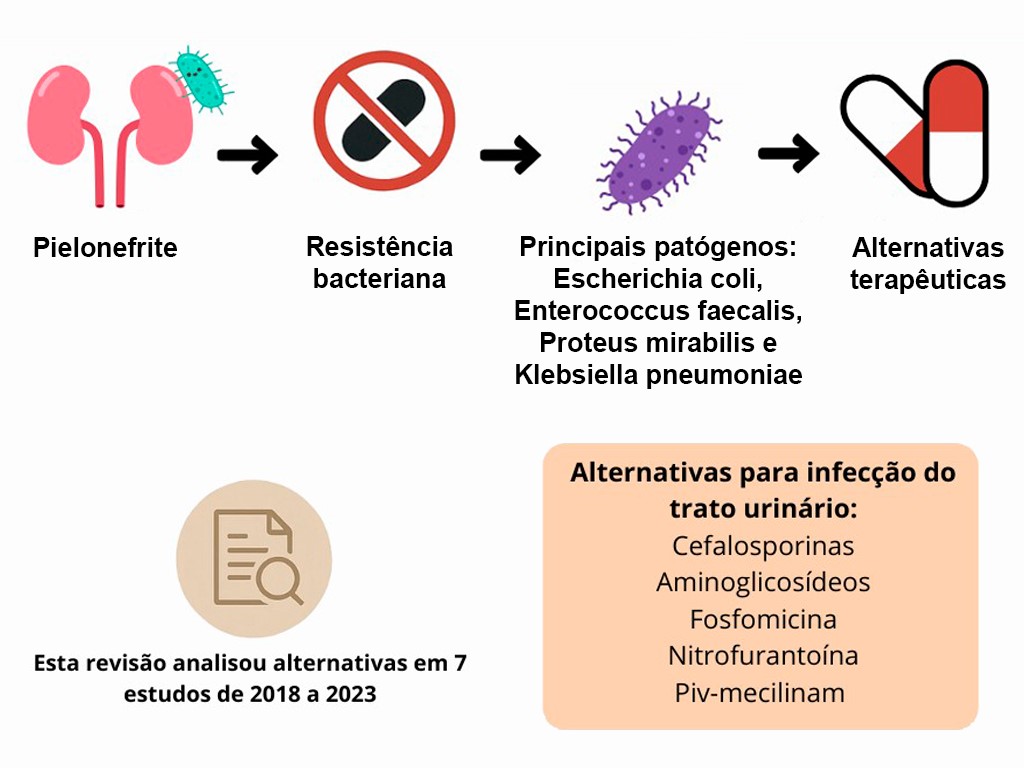Abstract
Pyelonephritis is a potentially serious kidney infection, usually caused by Gram-negative bacilli, such as Escherichia coli,
Enterococcus faecalis, Proteus mirabilis, and Klebsiella pneumoniae. Increasing bacterial resistance compromises the efficacy
of conventional antibiotics, making treatment difficult and increasing recurrences. This study, through a narrative review
based on seven articles selected from the PubMed and BVS databases (2018-2023), investigated therapeutic alternatives
to address antimicrobial resistance in cases of pyelonephritis. The studies analyzed highlighted the use of cephalosporins,
aminoglycosides, fosfomycin, nitrofurantoin and pivmecillinam as viable options, especially in patients with resistance to
first-line agents, such as fluoroquinolones and TMP-SMX. Clinical results showed similar efficacy between cephalosporins
and first-line antibiotics, with a lower rate of therapeutic failure associated with the former. In specific populations, such
as pregnant women and children, fosfomycin and pivmecillinam have been shown to be safe and effective, although they
require rigorous monitoring. It is concluded that the management of pyelonephritis requires attention to the bacterial
resistance profile, the patient’s clinical condition and the incorporation of evidence-based alternative therapies. Personalized
strategies and updated clinical guidelines are essential for therapeutic success and the prevention of complications,
especially in vulnerable populations.
References
1. Marques BT, Carvalho MM, Corrêa GR. Pielonefrite. Acta MSM. 2016;4(1):29-38. Disponível em: https://revista.souzamarques.br/index.php/ACTA_MSM/article/view/116
2. Adamy Junior A, Toni R, Yoshikawa GB, Kamei DJ, Sato TTK, Cioni M. Pielonefrite enfisematosa. Rev Med Paraná. 2015;73(2):81-4. Disponível em: https://cms.amp.org.br/arquivos/artigosrevistasarquivos/artigo-1387-revista-medica-do-parana-73-edicao-02-2015_1689360995.pdf
3. Gomel BM, Bolsi GT, Bremmer FP, Nisihara R. Pielonefrite aguda: susceptibilidade bacteriana em manejo hospitalar. 2019;63(4):384-7. Disponível em: https://oldsite.amrigs.org.br/assets/images/upload/pdf/jornal/1594127599.pdf#page=22
4. Kozyrakis D, Kratiras Z, Soukias G, Chatzistamou SE, Zarkadas A, Perikleous S et al. Clinical outcome and prognostic factors of sepsis, septic shock and prolonged hospitalization, of patients presented with acute obstructive pyelonephritis. J Endourol. 2020;34(4):516-22. https://doi.org/10.1089/end.2019.0801
5. Alós JI. Resistencia bacteriana a los antibióticos: una crisis global. Enferm Infecc Microbiol Clin. 2015;33(10):692-9. https://doi.org/10.1016/j.eimc.2014.10.004
6. Telhig S, Said LB, Zirah S, Fliss I, Rebuffat S. Bacteriocins to thwart bacterial resistance in gramnegative bacteria. Front Microbiol. 2020;11:586433. Disponível em: https://www.frontiersin.org/articles/10.3389/fmicb.2020.586433/full
7. Patini R, Mangino G, Martellacci L, Quaranta G, Masucci L, Gallenzi P. The effect of different antibiotic regimens on bacterial resistance: a systematic review. Antibiotics. 2020;9(1):22. https://doi.org/10.3390/antibiotics9010022
8. Li FF, Zhang PL, Tangadanchu VKR, Li S, Zhou CH. Novel metronidazole-derived three-component hybrids as promising broad-spectrum agents to combat oppressive bacterial resistance. Bioorg Chem. 2022;122:105718. https://doi.org/10.1016/j.bioorg.2022.105718
9. Chatzopoulou M, Reynolds L. The role of antimicrobial restrictions in bacterial resistance control: a systematic literature review. J Hosp Infect. 2020;104(2):125-36. https://doi.org/10.1016/j.jhin.2019.09.011
10. Fosse PE, Brinkman KM, Brink HM, Conner CE, Aden JK, Giancola SE. Comparing outcomes among outpatients treated for pyelonephritis with oral cephalosporins versus first-line agents. Int J Antimicrob Agents. 2022;59(4):106560. https://doi.org/10.1016/j.ijantimicag.2022.106560
11. Goodlet KJ, Benhalima FZ, Nailor MD. A systematic review of single-dose aminoglycoside therapy for urinary tract infection: is it time to resurrect an old strategy? Antimicrob Agents Chemother. 2019;63(1):e02165-18. https://doi.org/10.1128/AAC.02165-18
12. Bossa MAG, Mendez MH. Resistencia bacteriana en urocultivos de una población de embarazadas de control prenatal en Bogotá, junio 2013 – junio 2015. Biociencias. 2018;13(2):95-104. Disponível em: https://dialnet.unirioja.es/descarga/articulo/7063684.pdf
13. Sehested LT, Kamperis K, Winding L, Bjerre CK, Neland M, Hagstrøm S et al. Children with acute pyelonephritis need medical re-evaluation when home-treated with oral antibiotics. Acta Paediatr. 2021;110(9):2627-34. https://doi.org/10.1111/apa.15958
14. Weinstein EJ, Han JH, Lautenbach E, Nachamkin I, Garrigan C, Bilker WB et al. A clinical prediction tool for extended-spectrum cephalosporin resistance in community-onset Enterobacterales urinary tract infection. Open Forum Infect Dis. 2019;6(4):ofz164. https://doi.org/10.1093/ofid/ofz164
15. Martínez PJC, Pantoja EGC, Zayas EO. Infecciones del tracto urinário. Revisión bibliográfica. Cienc Serv Salud. 2018;9(1):20-7. https://doi.org/10.47187/cssn.Vol9.Iss1.23
16. Vogler S, Pavich E. Pyelonephritis treatment in the community emergency department: cephalosporins vs. first-line agents. Am J Emerg Med. 2018;36(11):2054-7. https://doi.org/10.1016/j.ajem.2018.08.016
17. Chong Y, Shimoda S, Shimono N. Current epidemiology, genetic evolution and clinical impact of extended-spectrum β-lactamase-producing Escherichia coli and Klebsiella pneumoniae. Infect Genet Evol. 2018;61:185-8. https://doi.org/10.1016/j.meegid.2018.04.005
18. Casas RL, Ortiz M, Erazo-Bucheli D. Prevalencia de la resistencia a la ampicilina en gestantes con infección urinaria en el Hospital Universitario San José de Popayán (Colombia) 2007-2008. Rev Colomb Obstet Ginecol. 2009;60(4):334-8. https://doi.org/10.18597/rcog.316
19. Salomonsson P, Linstow ML, Knudsen JD, Heiberg I, Mola G, Wenger TR et al. Best oral empirical treatment for pyelonephritis in children: do we need to differentiate between age and gender? Infect Dis. 2016;48(10):721-5. https://doi.org/10.3109/23744235.2016.1168937
20. Alsubaie SS, Barry MA. Current status of long-term antibiotic prophylaxis for urinary tract infections in children: an antibiotic stewardship challenge. Kidney Res Clin Pract. 2019;38(4):4410-54. https://doi.org/10.23876/j.krcp.19.091

This work is licensed under a Creative Commons Attribution 4.0 International License.
Copyright (c) 2025 Bianca Araújo Fernandes Veras, Igor de Sousa Oliveira, Sávio Benvindo Ferreira
